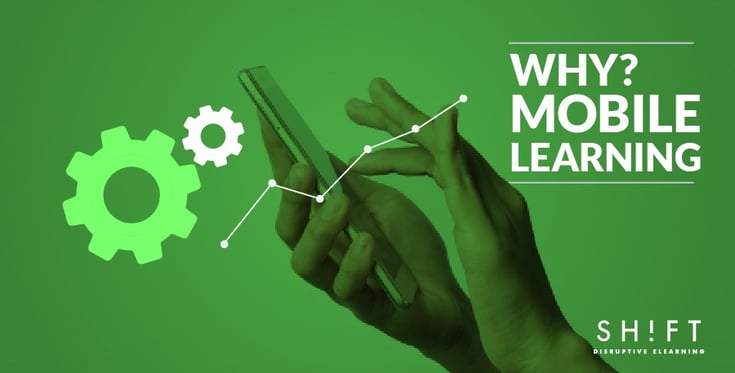There is no question about it: now is the time to embrace mobile. Mobile learning (mLearning), is a rapidly growing area for training and development departments in organizations of all industries. It provides companies the opportunity to reach and engage employees in new and striking ways.
In fact, a new global study by the Economist Intelligence Unit (EIU), discovered a measurable link between a mobile-first work environment and an increase in employee engagement. Also, it revealed that organizations that are mobile ‘pioneers’ saw a 16% boost in productivity, as well as improvements in creativity and loyalty.
If you haven't taken your training programs mobile yet, the following read will show you how many opportunities to grow, boost productivity, and improve your revenue you are missing out on.
“Twenty-first century learning is not confined to a geographical location, or a particular space designated for learning purposes” Colley & Stead, 2009.

Read mLearning stats: Mobile Learning Stats that Will Make You Rethink Your Training Strategy
1) Leveraging People's Desire to Participate
Mobile learning is personal and ultimately more engaging. FOMO (Fear of missing out) is a reality and is defined by Ravepubs as "the feelings of anxiety online users suffer when an exciting or interesting event may be happening elsewhere, at that moment, and they are not there". By taking training mobile, trainers can leverage the FOMO principle to inspire and push learners to actively participate in the courses. People love to respond to “happening now” content.
Another benefit of mobile learning is the ability to include more interactive and collaborative content, leading to higher participation and faster learning. Online communities and social media features in mobile learning environments are a great way to keep learners interested and engaged. Sharing examples and exchanging experiences between coworkers can be extremely valuable to the learning process.
Touchscreens on mobile devices can add a more immersive element to make the experience more engaging as well. Employees get to touch, drag, drop and play around with elements in a course to can get a much more powerful connection with content than by just clicking next on a screen.
Also, no one likes to be told when to be focused on something. The best way to learn is to be given a task and a deadline to complete on your own time. Having lessons accessible on any mobile device lets learners focus when they have the time and attention free to do so. An annoying training program will be overlooked when there’s a pile of work to be tackled. Let employees ease into the lessons at their own speed, on their own time.
2) Mobile Devices Allow Businesses to Distribute Learning Quickly
With the greater mobility of staff, training opportunities onsite are rapidly diminishing.
Learning doesn't happen at work or inside the cubicle anymore. It happens everywhere. An increasing number of people are now working remotely at home or in their favorite local spots. Even office workers who follow a routine 9-to-5 schedule get most work done outside the office. Work is possible as long as there is a smartphone, tablet, or laptop available. Basically, the 9-to-5 job era has ended.
mLearning provides an ideal solution for this "Workshifting" movement, particularly for industries that must cope with constant changes, by making it easy to disseminate learning materials to employees. Mobile learning can be applied to everything from product training, sales/marketing-related learning aids, to IT, and organizational compliance training. Features like these keep learners connected to their duties on an everyday basis. This makes for a more realistic completion as learners can pick up lessons where they left off or prep before a task.
"The correlation with business results is direct. Putting learning in the palm of people’s hands — exactly what they need, when they need it — can have an immediate positive effect on the bottom line". Mobile Learning: Driving Business Results by Empowering Employees in the Moment
3) Mobile Learning Can Deliver Key Data at Point of Need
Training departments are being shaped by the new demands of the mobile workforce. In fact, it's anticipated that by 2022, 1.87 billion people will be mobile employees, comprising 42.5% of the total global workforce. This means employees are no longer tethered to their desk and prefer to complete tasks on the go. They are expecting to access knowledge when they need it, wherever they are, and all done simply in their smartphone and at the touch of a button.
Besides, it’s going to be very difficult for your trainees to recall the specifics of a sales program right before a sales meeting. However, with access to the information in hand, your sales associates can go ahead and look up relevant information to refresh on points before starting a pitch or closing a deal.
Today’s learners look for the flexibility to learn on the device of their choice. Working styles and preferences in organizations are undergoing a sea change. Taking your training mobile is allowing both your company and your employees to remove delays in growth.
Features like these create new opportunities for employees to reference information when it counts the most. Also, providing your employees with more flexibility results in happier employees. Modern learners value flexibility in their schedule and their ability to choose when and how they work (and learn).
Read more: The Mobile Workforce – Everything You Need To Know in 5 Infographics
4) Not only for Millennials! Engage All Age Groups
Today’s multi-generational workforce ranges from Baby Boomers through to early 20's Millennials. It used to be that the younger generation (aka Millennials) would understand technology, but nowadays, everyone is in tune with the digital life.Mobile Learning is good for all your workers, not just millennials.
Employees are eager to stay connected to stay on top of everything. For many, mobile learning is simply the next step to their already digitized ‘on-the-go’ lifestyle. Having a mobile learning program in place is no longer going to service one key group, this is going to be relevant to all age groups in your company who are eager to advance in the workplace.
And don't forget Gen Z is coming! According to Brian Solis in his 25 Disruptive Technology Trends 2015–2016, “Generation Z is mobile first and mobile only”, therefore it becomes critical that your training is available on mobile devices.
Read more: Why Use Mobile Learning for a Multigenerational Workforce
And More! Mobile Learning Provides a Number of Less Tangible Organizational Benefits
There are several more benefits to mobile learning that are no less important than the above. These include:
- Empowering individuals to develop skills. This often leads to higher employee motivation and reduced staff turnover, reducing recruitment costs.
- A higher retention rate of knowledge. Employees can access information whenever they need it and archive notes for later reference (Mobile Learning and Student Retention Report, 2007).
- Increased motivation. Mobile devices have been found in improve engagement with learning (The 2010-2011 Horizon Report).
- An easier learning process. mLearning is more attractive and acceptable to disenfranchised employees than traditionally learning methods, according to Attewell, 2005.
- Removing formality. Mobile learning removes the sense of formality attached to education that non-traditional learners find unattractive, says Attwell 2005.
It's time for us as learning professionals to bring our eLearning into the mobile world. If not, we run the risk of being hurled into the abyss of obsolescence, along with the VHS, Mini-disk, and HD-DVD.
Just take a look at this stat:
"More than 70% of employees use search engines to learn what they need for their jobs; will unlock their smartphones 9 times an hour, and watch videos for no longer than 4 minutes".
Further references:
Gary Woodill, Ed.D. "Calculating the Return on Investment (ROI) of Your Mobile Learning Initiative". 2011.
Cognizant. " Mobile Learning: Driving Business Results by Empowering Employees in the Moment". November 2012.
Field Guide: Building a Business Case for Mobile Learning


